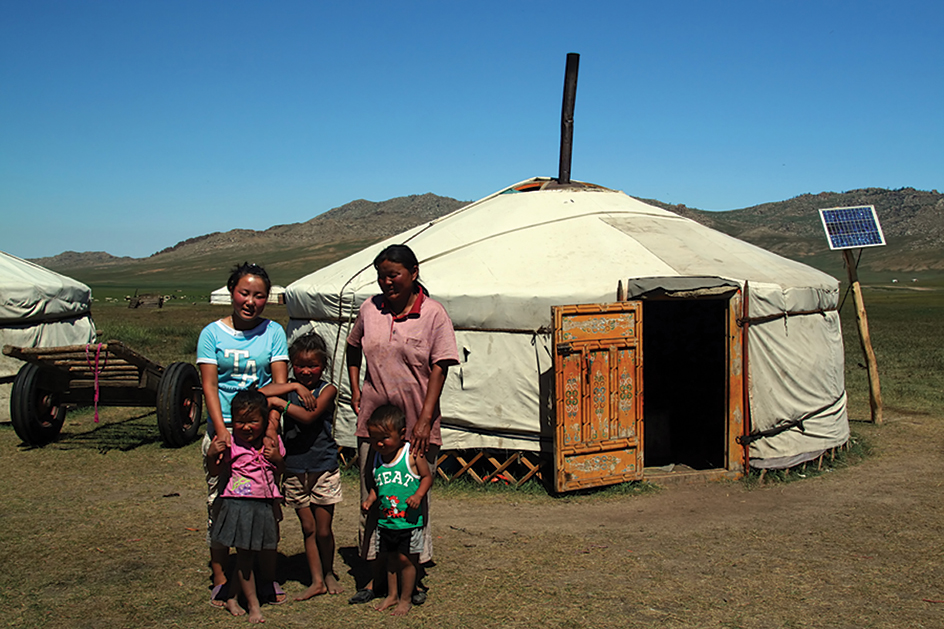Family is the basic unit of social organization in human societies. The meaning of family has changed over time. In modern usage, family generally refers to a group of people related to one another by birth, marriage, or adoption. But, family can also describe any group sharing a strong sense of connection. Such a group may include kin, such as cousins, aunts, uncles, and more distant relatives. A family can even include unrelated individuals with whom people live or spend much time.
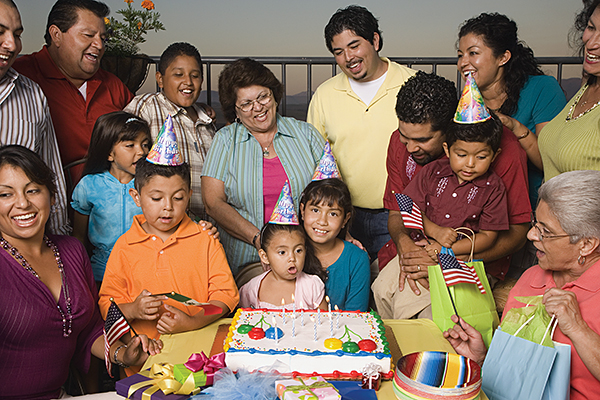
Scholars consider family living to be among the most important adaptations in the evolution (gradual development) of humans. Families protect children long enough for their brains to grow and develop to a high degree. In doing so, families may have enabled early humans to acquire complex culture. Since prehistoric times, families have helped individuals as well as groups and even nations to thrive.
Varieties of families
Family types vary in different countries and among different cultures. The nuclear family—a social unit made up of a father, a mother, and their children—is often assumed to be the most basic and common type of family, especially in Western societies. However, most people have historically lived in other types of families, and today the nuclear family is becoming increasingly uncommon. Throughout history and in many different societies, people have lived in extended families. In such a family, a variety of family members—such as grandparents, aunts, uncles, nieces, nephews, and cousins—live together. These complex families commonly include three or more generations. Many people in rural parts of Africa, Asia, and Latin America continue to live in extended-family households. Even those who move to cities are likely to visit and otherwise maintain regular contact with dozens of members of their extended families.

Today, many adults in Western societies live alone. Many children grow up in single-parent families, with just one adult, or in blended families, often formed by the marriage of parents who have their own children. Parents who stay together may spend decades in empty nest families after their children have left home.
An increasingly common family form in Western societies is the consensual union, in which couples live together but remain unmarried. When a same-sex couple decides to live together as a family, they may form a same-sex union. Such unions have become more common and more widely accepted, but most countries do not recognize them as legal families. Same-sex marriages are legal in many European countries and in South Africa, Canada, and Argentina. In 2015, a United States Supreme Court ruling made it illegal for states to ban same-sex marriage. Many same-sex families also include children, who may be the birth children of one or both partners or may be adopted.
Some cultures continue to practice polygamy, in which a person can have more than one spouse (husband or wife). The two chief forms of polygamy are polygyny and polyandry. In polygyny, a man marries more than one woman. In polyandry, a woman has more than one husband. Polygamy was much more widespread in the past. It is still legal or practiced in parts of Africa, the Middle East, and Southeast Asia.
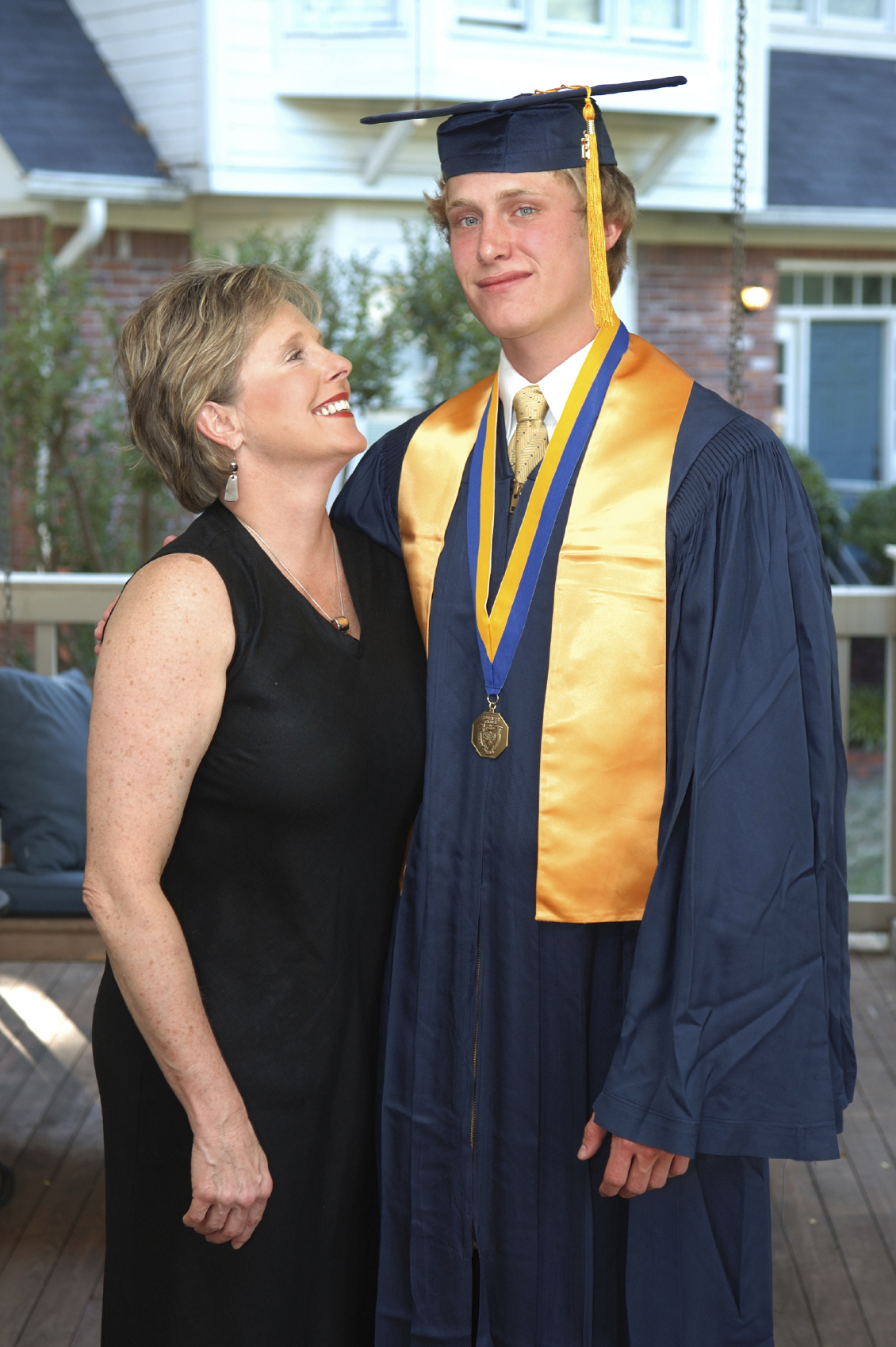
Family relationships
Family members can be legally related to one another by consanguinity (blood relationship); by affinity (marriage); or through adoption. Adoption is a legal procedure to make a child a family member. Brothers and sisters who share the same parents are siblings. Half brothers and half sisters share either the same biological mother or biological father. When parents with their own children marry, the parent’s new spouse becomes the children’s stepfather or stepmother. Children from outside the marriage become stepbrothers and stepsisters to one another.
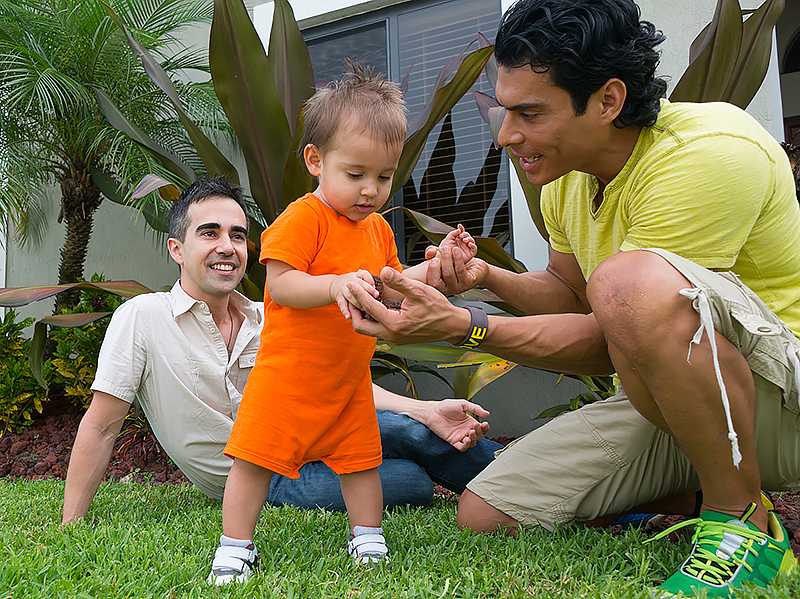
When people marry, they gain a set of relatives called in-laws. The mother of a person’s spouse is called a mother-in-law, the brother is called a brother-in-law, and so on throughout the rest of the family.

The parents of a person’s mother or father are that person’s grandparents. Great-grandparents are the parents of a person’s grandparents. An aunt is the sister of a person’s mother or father. An uncle is the brother of a parent. An uncle’s wife is also called aunt, and an aunt’s husband is also called uncle. A first cousin is the child of a person’s aunt or uncle. The child of a first cousin is a person’s first cousin once removed—that is, removed by one generation. Children of first cousins are second cousins to each other.
Some people consider certain friends as part of their family because they feel special affection for them. Such friends are called fictive kin, and family members might call them “aunts” or “uncles.” Relatives or close friends of a parent may become godparents to that parent’s children. Godparents, as sponsors to a Christian baptism, often play vital roles in the lives of families. In Latin American and Hispanic American families, godparents, called compadres, provide advice, emotional support, and assistance in times of need. The Spanish American custom of asking someone of higher status to serve as a child’s godfather is referred to as compradrazgo.
In many non-Western societies, family relationships can help determine where a family lives. In patrilineal societies, the main line of kinship is drawn through a child’s father. Such societies, including many in India, China, and Africa, are usually patrilocal—that is, a husband and wife commonly reside with the husband’s father and his kin after marriage. In matrilineal cultures, on the other hand, lines of kinship are drawn through the mother. Such cultures, including the Navajo and the Pueblo of the American Southwest, are usually matrilocal—that is, a husband joins his wife’s mother’s household. In cultures with a bilateral kinship system, such as that of the Inuit, a couple might join either the husband’s father’s family or the wife’s mother’s family or form an independent household.
Importance of the family
Family functions.
Families perform many necessary functions, both for individual family members and for society as a whole. In virtually all cultures, the family serves as the basic institution for bearing children, caring for them during their early years, and preparing them to function effectively in society. Families around the world must also provide food and clothing to their members. In addition, families meet important psychological needs, such as the need for love, support, and companionship.
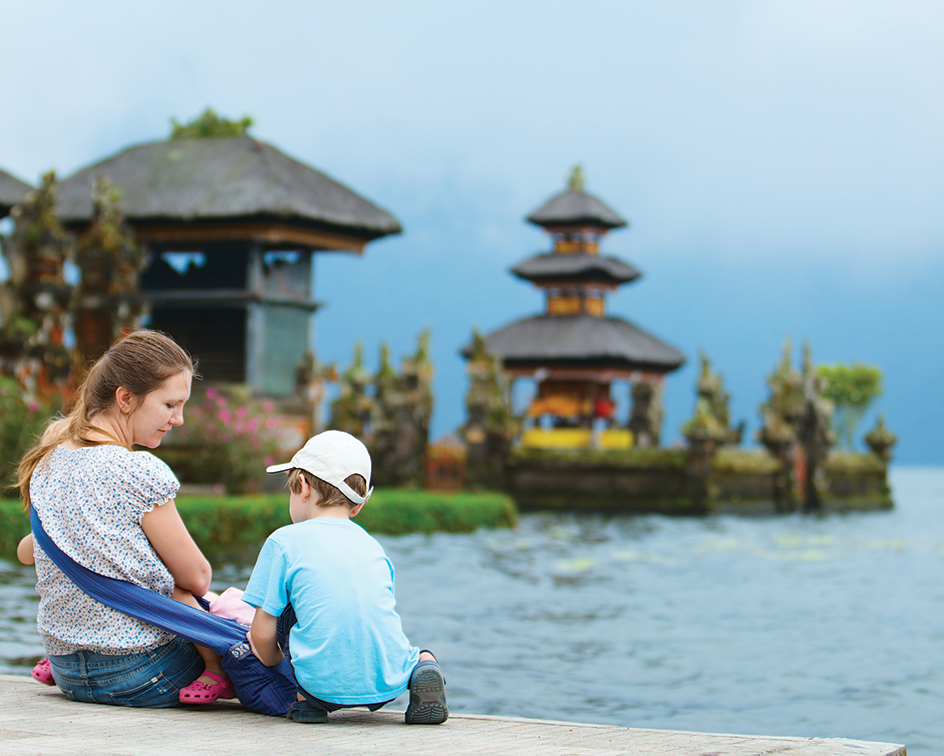
T he family’s duties have changed over time. Historians refer to families hundreds of years ago as “complete institutions” because they performed many functions later taken over by larger groups. Early families not only cared for the young but also grew their own food, made their own clothing, and provided such services as teaching children crafts and reading and writing. Orphaned children or adults unable to care for themselves were sent to live with families in the community.
Institutions such as schools, hospitals, and homes for people who were orphaned, insane, poor, or disabled rose to prominence in Western societies beginning in the 1800’s. These institutions took over some of the care and other functions that had been provided by families. In the 1900’s, many governments began providing financial support to help impoverished families to stay together. As the responsibilities of the family were reduced, greater emphasis was placed on the roles that remained, especially emotional support and affection. Today, families in Western societies are often less concerned with survival than with looking after the happiness and well-being of their members.
Home life.
The home is the center of family activities. These activities include raising children, eating meals, playing games, watching television, keeping house, and entertaining friends. In the home, children learn basic social skills, such as how to talk and how to get along with others. They also learn diet, health, and safety habits there.
A family’s home life is influenced by which members live in the home and by the roles each member plays. Home life can also be affected by relatives who live outside the family’s home. Traditions, laws, and social conditions help determine who lives in a home and the place each family member holds.
Traditions
—customs or beliefs that people have followed for a long time—strongly influence family life. For example, some Americans have little contact with relatives outside the nuclear family. However, in much of the world and among many minorities and immigrants in the United States, extended relatives traditionally play important roles in family life. Among many groups, cousins may regard each other like brothers and sisters, and a child’s aunts may be as close as his or her mother.
Laws
affect family behavior in various ways. Some laws set forth the legal rights and responsibilities people have as husbands, wives, parents, and children. In many Western nations, laws forbid the abuse of children by parents and of one spouse by the other. Laws also deal with marriage, divorce, and adoption, for example determining at what age someone can marry or whether cousins can marry each other.
Social conditions
can also influence family life. In some regions of the Middle East, for example, women are discouraged from working outside the home or driving automobiles.
Development of the family
Ancient families.
For most of human history, people lived and moved in small bands of related individuals that hunted and gathered their food. The cultures and practices of such groups varied greatly depending on environmental conditions. However, the groups shared certain features. Nearly all were small in size, moved often, and were largely egalitarian—that is, there were not large differences in status or social standing among adults. Women and men usually performed different roles, with women doing most of the child rearing and men doing most of the hunting, for example. All adults had to work cooperatively to survive, and women commonly contributed more food to the group than did men. Only a few such societies have persisted beyond the early 1900’s.
Great changes came to societies and to families with the development of agriculture, starting around 10,000 years ago in parts of the Middle East, East Asia, and Northeast Africa. Growing food made it possible for people to live in larger groups in permanent settlements. The ability to settle in large groups led to the development of nations and civilizations, with powerful rulers and organizations to wage war, collect taxes, and otherwise manage affairs. Positions of power were usually filled by men, and differences in social status grew between the rich and poor. The wealthiest households included dozens of kinsfolk, servants, and slaves.
One of the earliest written collections of laws is the Babylonian Code of Hammurabi, written around 1750 B.C. The code has provisions that cover family law. It formally approved of the patriarchal family arrangement, in which the father has complete power over his children and wives. In ancient Egypt, women had almost as many rights as did men. But few other ancient civilizations gave women as many rights. In ancient China, Greece, and Rome, the patriarchal family was considered ideal. Rulers relied heavily on family relationships. They often inherited their positions and commonly conducted politics and trade through trusted kin.
Many ancient cultures also permitted divorce and often practiced polygyny and concubinage, the practice of a husband taking to live with him a woman who was not his legal wife. Polygyny and concubinage enabled a powerful or wealthy family to bear children when a man’s first wife failed to produce an heir, a child who could inherit the family’s wealth.
Development of the Western family.
The growth of Christianity played a crucial role in the emergence of new family patterns. Early Christians commonly pooled their possessions and became like family to one another. Women also took on important roles in the early church. During the early Christian era, around the A.D. 300’s, family patterns in Western Europe began to diverge from those in the non-Western world. Western European families placed a greater emphasis on the bond between husband and wife, as opposed to broader kinship relationships. Christianity in Europe also began to emphasize the control of sexual desire. It encouraged young people to remain celibate (not participating in marriage and sexual relations) and to enter religious orders. The church also condemned arranged marriages, polygyny, divorce, infanticide (the killing of infants), marriage between close family members, concubinage, and prostitution.
During the Middle Ages in Europe, which lasted from about the A.D. 400’s through the 1400’s, family life was unstable and complex. Famine, plagues, and other calamities caused a radical decline in population, depressed economies, and devastated families. Poverty forced many parents to send their children away from home at young ages. Such children became servants in wealthy homes, apprentices in a trade or business, or church workers. The high death rate led many people to remarry. Many medieval families included stepparents and stepchildren, and many children grew up without or apart from their birth parents.
The wealthiest households could have 40 or more people. These inhabitants included servants and other nonrelatives. But the average medieval household was much smaller, containing about four or five members. Most families lived in cramped houses that lacked privacy. Relatives often shared beds and used the same rooms for working, entertaining, cooking, eating, storage, and sleeping.
The Reformation of the 1500’s, a religious movement that led to Protestantism, had a tremendous effect on social, political, economic, and family life. Protestant reformers criticized the Roman Catholic Church for allowing children to marry without parental consent. But the Protestants also put more emphasis on marriage. They believed that clergy should be able to marry and that marriages that had broken down could be ended by separation or divorce. Protestant countries recognized a right to divorce with remarriage in cases of abandonment, adultery, and extreme physical cruelty.
Early American families.
During America’s colonial period, which lasted from the 1500’s to 1775, family life varied. The Spanish settlers who colonized Florida and the American southwest were usually male. They often married local Indian women. English settlers in the 1600’s in what is now Virginia and Maryland were less likely to intermarry with native peoples. However, a lack of women colonists and high death rates from disease and famine made it difficult for English colonists to form stable families. Many children were raised by step-parents, as widowed husbands and wives usually remarried within a year.

Puritan colonists, members of a religious movement that began in England, had more stable societies and families. Most Puritans arrived as families in New England starting in the 1620’s. Puritan families were large and many children were raised with grandparents. Puritan family relations were affectionate but strict.
Like the families of Europe, colonial American families were patriarchal. The father’s control over inheritance kept his grown sons and daughters dependent for years, while they waited for his permission to marry and to establish a separate household. Relations between spouses tended to be formal. Husbands and wives treated each other with correct, serious manners rather than the relaxed, friendly interactions common today.
Family life was extremely difficult for Native Americans in the colonial period. Once European colonists arrived, Native American populations were devastated by disease and warfare. Most Native American societies were based on lineage and kinship, and one’s identity and welfare depended on relationships with many relatives. Some Indian groups disappeared altogether or joined with survivors of other groups to create new groups, such as the Seminole or Catawba.
African American families faced unique problems in early America. Nearly all African Americans came to North America as slaves. The mixing of people from different African societies during the slave trade made it difficult for individuals to maintain their traditional languages and cultural practices. Slave life also made forming and maintaining families difficult. By the early 1700’s, slaves born in the Americas had created an African-American family culture that blended African traditions with elements of European cultures, such as Christianity.
By the early 1800’s, many American slaves married and lived in families, but they remained vulnerable to separation and other abuse. Many states refused to recognize slave marriages as legal. Moreover, about a third of all slave marriages were broken by sale, and about half of all slave children were sold from their parents. Even when sale did not break the marriage, slave spouses often resided on separate plantations.
Despite all these obstacles, enslaved African Americans forged strong family and kinship ties. It was common for children separated from their parents to be raised by grandparents, aunts and uncles, or fictive kin acting as mothers and fathers. Once slavery ended in the United States, former slaves settled into stable families. However, poverty drove many wives to work outside the home, often as domestic servants in white homes.
Changes.
Family life began to change in the late 1700’s. As land became scarcer in New England, young men had less hope of someday inheriting land from their parents. They instead left home to seek their fortune on the frontier or in growing towns and cities. Daughters became much more likely to marry out of birth order and had more freedom in selecting a husband. Parents treated each other and their children with more affection than in earlier times. Parents also became more interested in their children’s development, buying children books, games, and toys.
During the early 1800’s, many middle-class families became able to rely on a single wage earner, with the husband working outside the home and the wife serving as full-time homemaker and mother. Many of these families could afford to keep children at home into their late teens, instead of sending them out as servants or apprentices. By the mid-1800’s, such family traditions as the vacation and the birthday party had appeared.
For many working-class families, however, low wages and a lack of year-round employment meant that all family members had to seek employment. As the wages of men fell, families relied more on children and wives to earn income. Many factory owners prized the labor of women and children, who could tend machines as well as did men but at lower wages. Many working-class families were immigrants or the children of immigrants. Before the American Civil War (1861-1865), most immigrant families came from Germany and Ireland. Later, immigrant families from other parts of Europe and Asia arrived. Most immigrants relied heavily on the labor of their children in factories or on farms.
By the end of the 1800’s, the divorce rate in Western societies was rising. Infant and child death rates were high, with as many as a third of children dying by the age of 15. Meanwhile, more and more Western women never married, and the birth rate had fallen sharply during the 1800’s. Instead of bearing seven or more children, as women had in 1800, a typical middle-class woman in the United States bore only three.
Family changes in the United States continued into the 1900’s. Prosperity spread to more families, and workers had more leisure time. Developments in medicine and sanitation added years to the average person’s lifespan. To improve the health and plight of children, reformers lobbied for an end to child labor. They also fought for special pensions (regular payments) to enable widows to raise their children at home, instead of sending them to orphanages.
By the 1920’s, most American families owned an automobile. Families spent more time on recreation, enjoying such inventions as record players, radios, and motion pictures. High school and college students spent more and more time dating or socializing with their peers. Families grew less patriarchal. A new family ideal became popular by the 1920’s. This ideal, called the companionate family, held that husbands and wives should be “friends and lovers” and that parents and children should enjoy friendlier relations.
During the Great Depression of the 1930’s, families struggled as it became more difficult to make a living. The number of women working outside the home rose, and young people left school early to help their families by earning money. The divorce rate fell because fewer people could afford divorce, but many fathers deserted their families.

World War II (1939-1945) also subjected families to severe strain. Millions of husbands and fathers served in the armed forces, and people of all ages moved to cities, where factories for war materials offered relatively high pay. With so many parents away at work or war, children were often unsupervised. These “latchkey children,” returning from school each day to an empty home, led to growing concerns over juvenile delinquency. The rate of both marriage and divorce rose during the war. Economic conditions improved after nations increased their production of war materials at the start of the conflict. This increased level of production substantially reduced unemployment, but it also forced many families to move to take jobs.
During the postwar years of the late 1940’s and 1950’s, adults turned to the family for a sense of stability. The standard of living rose sharply. The divorce rate slowed, and couples married younger than their parents had. Women bore more children at younger ages and closer together than in the past. The result was a sharp increase in children called a “baby boom.” A powerful youth culture developed, embracing rebellious figures such as the singer Elvis Presley and the actor James Dean.
A movement toward permissiveness grew in the 1960’s. Children born during the baby boom had grown up in comfort with few responsibilities. Unlike their parents, many resisted settling down to a steady job and family life. The availability of reliable birth control and the legalization of abortion in the early 1970’s made it easier to pursue sexual relationships for pleasure, rather than the establishment of families. The number of women, including mothers, working outside the home continued to grow. From the early 1970’s, the growth of feminism led many women to question male privileges that had been taken for granted by previous generations. More and more women could make their own living, and fewer and fewer considered marriage to be essential to a good life.
Families in the United States have become more diverse. The number of children born outside of wedlock has soared, even as the birth rate has declined since the 1950’s. At the same time, many people who could not legally form families are able to do so. In 1967, the U.S. Supreme Court struck down state law against interracial marriages. In 2015, it did the same for same-sex marriages. Mixed-race marriages, same-sex unions and marriages, and interracial and international adoptions have all increased.
Global trends.
Non-Western societies traditionally have attached less importance to the nuclear family than to the larger family network. People in this network, often called the lineage, clan, or tribe, trace their descent to a common ancestor. In many parts of the world, kinship ties determine whom one can marry and where one lives after marriage. Different kinds of societies have produced different extended-family traditions.
Since the mid-1900’s, families around the world have become more similar. Trends that have changed families in Western societies have also affected non-Western families. Economic changes toward manufacturing and away from agriculture have pushed people from rural areas into cities, often weakening kinship networks.

Political policies also affect families. From the late 1970’s to 2015, China had a one-child policy that strongly discouraged couples from having multiple children. The government hoped that this measure would help China’s economy to develop and help ease the environmental damage caused by overpopulation. However, Chinese families traditionally valued sons more than daughters. These factors encouraged the selective abortion of female fetuses, and the proportion of males to females in China has become unbalanced. Many Chinese parents continue to believe that sons are more likely to improve the economic status of the family.
Parents throughout the world are having fewer children. Decreasing birth rates in China, Japan, and Europe, combined with rising life expectancy, will result in more and more elderly people relying on fewer younger adults for support.
In Mexico, Central America, Africa, and the Philippines, young men and women often leave to seek jobs in Europe, the United States, and Arab countries. Wages from these workers have helped their families back home, even as their absence has weakened family relations.
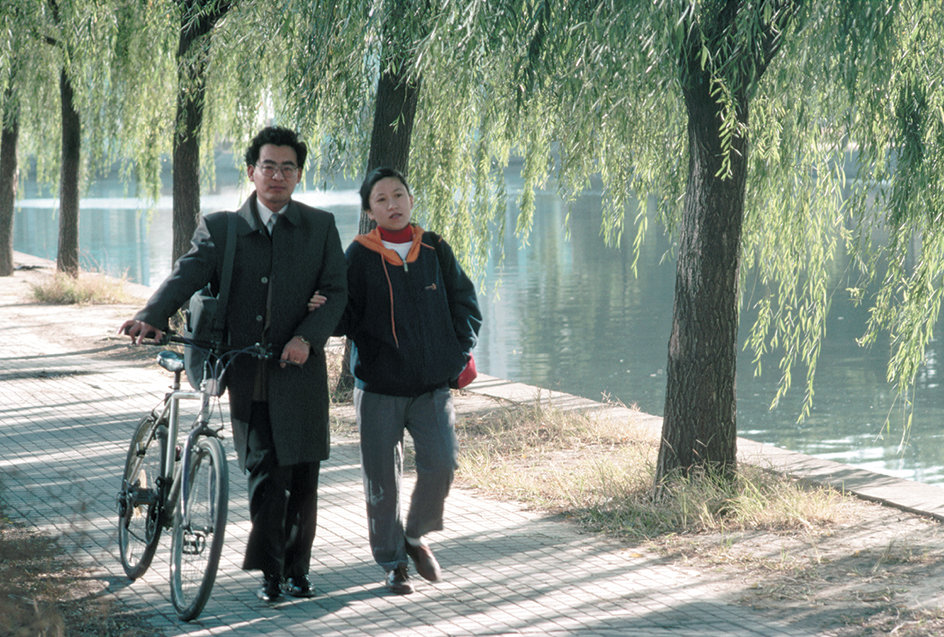
The global distribution of movies, television, and popular music have had a significant impact on family life. In many countries, parents complain that Western influences spread through the media have made the younger generation less disciplined and responsible. Families will continue to face many challenges as they attempt to balance the demands of work and family life amid changing economic, political, and environmental factors.
